Embracing Video Marketing Adoption for Business Growth in 2023
- Home
- Embracing Video Marketing Adoption for Business Growth in 2023
Picture this: you've finally decided to take the plunge and adopt video marketing for your business. Beneath the surface of video marketing lies a complexity that requires exploration - our guide provides an in-depth look into how to successfully adopt it for your business. That's where our in-depth guide on Video Marketing Adoption comes in handy.

In this blog post, we'll explore various aspects of incorporating video marketing into your strategy - from understanding how visual communication is transforming businesses to leveraging data analytics tools effectively. We will also delve into topics like balancing storytelling with metrics, using webinars as a powerful tool in 2023's landscape, and optimizing conversion rates through different forms.
Moreover, we'll discuss the crucial role of SEO in Video Marketing Adoption and provide tips for creating engaging thumbnails that capture attention. Lastly, we'll reveal how you can use video data for segmentation and lead scoring to make informed targeting decisions.
So buckle up and get ready to elevate your marketing efforts by adopting an effective video strategy!
Table of Contents:
- The Transformational Shift to Visual Communication
- Balancing Storytelling and Metrics in Video Marketing
- Quantitative Side of Video Marketing Adoption
- Webinars as an Essential Tool in 2023's Video Landscape
- Conversion Rates Through Different Forms: Video Sign-Up Magic
- The Role of SEO in Video Marketing Adoption
- Leveraging Video Data for Segmentation and Lead Scoring
- FAQs in Relation to Video Marketing Adoption
- Conclusion
The Transformational Shift to Visual Communication
The digital world has undergone a massive transformation, with video marketing taking center stage.
As more people embrace video for online communication, businesses must adapt and leverage this trend to stay competitive.
Video Content Driving Increased Web Traffic
Did you know that videos account for 80% of global internet traffic? (source)
This means incorporating video marketing efforts into your strategy can significantly boost web traffic and increase brand awareness.
Higher Lead Generation Through the Use of Videos
Did you know that videos generate 66% more qualified leads per year compared to other content formats?
Incorporating video content in your marketing strategies not only engages your target audience but also helps drive conversions and sales growth.
- Craft compelling video material that is pertinent to your target audience's preferences and requirements.
- Publish consistently across various platforms such as YouTube, social media platforms, or even on your website's blog section.
- Analyze viewer engagement metrics like watch time, click-through rates, and shares to optimize your video marketing strategy.
Ready to leverage video marketing and create an effective video strategy?
Dive into our comprehensive guide on creating a winning video marketing strategy that will help you stay ahead in this ever-evolving digital landscape.
Balancing Storytelling and Metrics in Video Marketing
Let's dive right in.
To achieve a successful video marketing strategy, it's essential to strike the perfect balance between storytelling, human interaction, funnels, KPIs (Key Performance Indicators), and metrics.
But how do you find that sweet spot?
Don't worry; I've got your back with some actionable tips.
Importance of Having Clear Goals for Your Video Campaigns
The first step is defining clear goals for your campaigns.
This will help you create content that resonates with your audience while also being results-oriented across various platforms like social media channels or expert interviews.
Various Ways Video Can Be Results-Oriented
- Create videos specifically designed to drive traffic to a landing page or product page on your website. This can be achieved by including strong calls to action within the video itself.
- Leverage user-generated content (UGC) by encouraging customers to share their experiences using your products or services through video testimonials. These authentic stories can build trust among potential buyers and lead to higher conversion rates. Check out this guide on UGC benefits.
- Educate viewers about industry trends or offer solutions through explainer videos, tutorials, webinars - anything that adds value to your audience. This can position your brand as a thought leader and drive engagement.
Let's discuss the significance of metrics in refining your plan now that you have a few concepts on how to create video content that yields results.
Measuring Success with KPIs
KPIs are essential for understanding the effectiveness of your video marketing efforts.
Some common KPIs include:
- View count: The number of times people watch or engage with your video
- Average view duration: How long viewers typically spend watching a particular piece of content
- Click-through rate (CTR): The percentage of users who click on calls-to-action within or around the video player
- Social shares: How often users share videos across social media platforms, indicating their virality potential. Buffer has an excellent guide on increasing social media engagement here.
In conclusion, balancing storytelling and metrics is key to creating engaging and effective video marketing campaigns. By setting clear goals, producing results-oriented content, and measuring success through relevant KPIs - you'll be well-equipped to optimize your strategy moving forward.
To succeed in video marketing, it's important to balance storytelling and metrics by setting clear goals for your campaigns and creating results-oriented content that educates viewers about industry trends or offers solutions. Measuring success through relevant KPIs such as view count, average view duration, CTR, and social shares is also crucial in optimizing your strategy moving forward.
Quantitative Side of Video Marketing Adoption
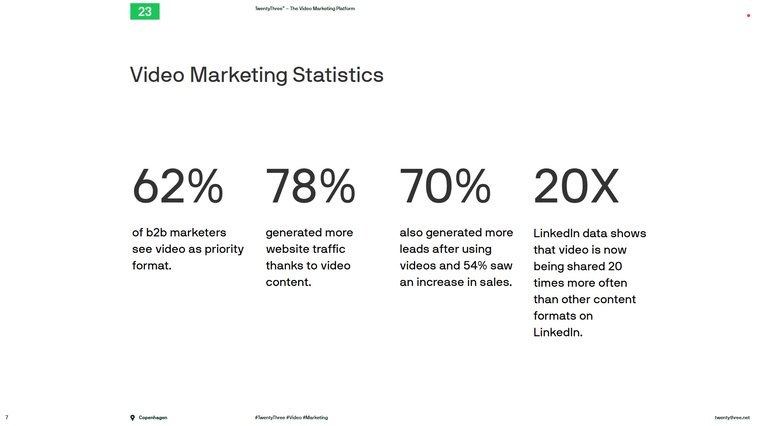
Let's delve into the quantitative aspects of video marketing adoption, shall we?
Understanding the quantitative side of video marketing adoption is crucial for success. By analyzing data on engagement rates and other key performance indicators (KPIs), you can make informed decisions about how best to optimize your strategy moving forward.
Identifying Relevant KPIs for Measuring Success
To start with, it's essential to identify relevant KPIs that align with your business goals. Some common video marketing KPIs include view count, watch time, click-through rate (CTR), conversion rate, and social sharing metrics. Pick a few that matter most to you and focus on tracking those consistently over time.
Using Data Analytics Tools Effectively
Data analytics tools are invaluable when it comes to making sense of all this information. Here's a quick rundown of some steps in using these tools effectively:
- Step #1: Integrate your chosen tool within your website, landing pages, or social media channels.
- Step #2: Set up custom goals and events to track the KPIs that matter most to your business.
- Step #3: Regularly review your data, as it will help you identify trends, patterns, and areas for improvement.
By utilizing the intelligence acquired from data analysis, one can make educated choices regarding how to allocate resources or enhance their video advertising plan. For example, if a particular type of content is generating high engagement rates, consider producing more videos in that style.
In short: Don't be afraid of numbers - they're here to help. Embrace the quantitative side of video marketing adoption by identifying relevant KPIs and using data analytics tools effectively. By utilizing data-driven insights, you can ensure that each choice is supported by sound proof - leading to improved outcomes.
Webinars as an Essential Tool in 2023's Video Landscape
Let's talk webinars, shall we?
These nifty tools have experienced a significant surge in popularity post-pandemic and are now considered indispensable for modern digital marketing strategies.
But why all the hype?
Integrating Webinars into Various Aspects of Business Operations
To make the most out of webinars, you need to think beyond traditional uses like product demos or educational sessions.
- Lead generation: Host informative sessions that showcase your expertise while capturing leads through registration forms.
- Sales enablement: Equip your sales team with webinar recordings to share with prospects during their buying journey.
- User onboarding: Create interactive tutorials that guide new customers through using your products or services effectively.
Optimizing Webinar Scheduling Based on Attendance Rates
Finding the perfect time slot is essential when planning a successful webinar.
- Analyze past attendance data to identify the most popular days and times for your audience.
- Consider time zones: If you have a global audience, try to find a time that works well across different regions.
- Experiment with scheduling: Test various dates and times to see which ones yield the highest attendance rates.
Remember, webinars are more than just a trend; they're an essential tool in 2023's video landscape. As the head of marketing for a small company with specific growth targets but limited internal resources, incorporating video marketing into your strategy is crucial. Webinars are a great way to leverage video marketing and increase brand awareness.
By embracing their versatility and optimizing your scheduling strategy, you'll be able to make the most of this powerful marketing tool. Webinars can help you engage customers, increase conversion rates, and drive customer acquisition. So, start creating video content and sharing videos on social media platforms, email marketing, and other channels to raise brand awareness and drive engagement.
Conversion Rates Through Different Forms: Video Sign-Up Magic
Let's face it, pop-up windows are so 2000s and they convert at a measly less than 1%. But wait, there's hope. Welcome to the world of video sign-up forms - your new best friend for higher conversion rates.
By incorporating sign-up forms directly into videos, you're creating an engaging experience that captures leads like never before. No more annoying pop-ups or intrusive banners; just seamless integration with your content.
You might be wondering about skippable vs. non-skippable options in video marketing campaigns. Fear not. Both have their merits when used strategically to optimize results without sacrificing user experience (UX).
- Skippable ads: These give viewers control over their UX while still exposing them to your message. Plus, you only pay if they watch the whole ad.
- Non-skippable ads: Although less flexible for users, these can guarantee full exposure to your content - perfect for short yet impactful messages that need undivided attention.
Supercharge Your Conversion Rates Today.
To truly harness the power of video marketing, you must balance storytelling with metrics and leverage the right tools and strategies. Incorporating video sign-up forms and optimizing ad formats can help you increase your conversion rates.
Ready to take your video marketing game to new heights? Dive into our comprehensive guide on Video Marketing Adoption here.
The Role of SEO in Video Marketing Adoption
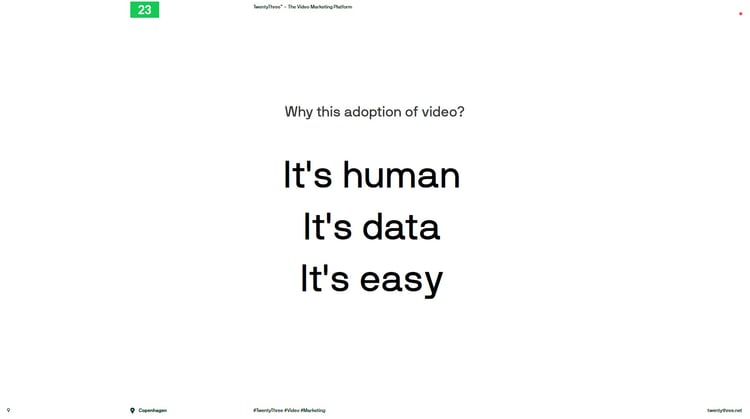
Let's talk about search engine optimization (SEO) and its significance in video marketing adoption.
Why, you ask?
Well, it's simple - to make your videos more visible on search engines and drive traffic to your content.
We'll explore some key aspects of SEO for videos that will help you stay ahead of the game.
Importance of Accurate Transcriptions for Accessibility and Translation
First things first: transcriptions are essential not only for accessibility but also for translation purposes.
This means reaching a wider audience while improving user experience - win-win.
Tips for Creating Engaging Thumbnails That Capture Attention
Moving on to thumbnails...
An engaging thumbnail is like an irresistible invitation to click on your video.
Creating a captivating thumbnail is crucial as it represents the first impression viewers have of your content.
Now that we've covered transcriptions and thumbnails, let's discuss other essential SEO elements for videos.
Metadata, Titles, and Descriptions
Metadata is the backbone of SEO for videos. Adding relevant keywords to your metadata, including titles and descriptions, helps search engines understand what your content is about - leading to better rankings.
Incorporating these tips into your video marketing strategy will boost visibility on search engines and drive more traffic toward your content.
So go ahead - optimize those videos like a pro.
Leveraging Video Data for Segmentation and Lead Scoring

Let's talk about something super important in the world of video marketing: data.
Did you know that using video analytics effectively can help you drive segmentation strategies, lead scoring efforts, and workflow optimizations? This means your business can target the right audience at the right time with tailored messaging that resonates strongly with potential customers. Pretty cool, huh?
Using Video Analytics to Inform Targeting Decisions
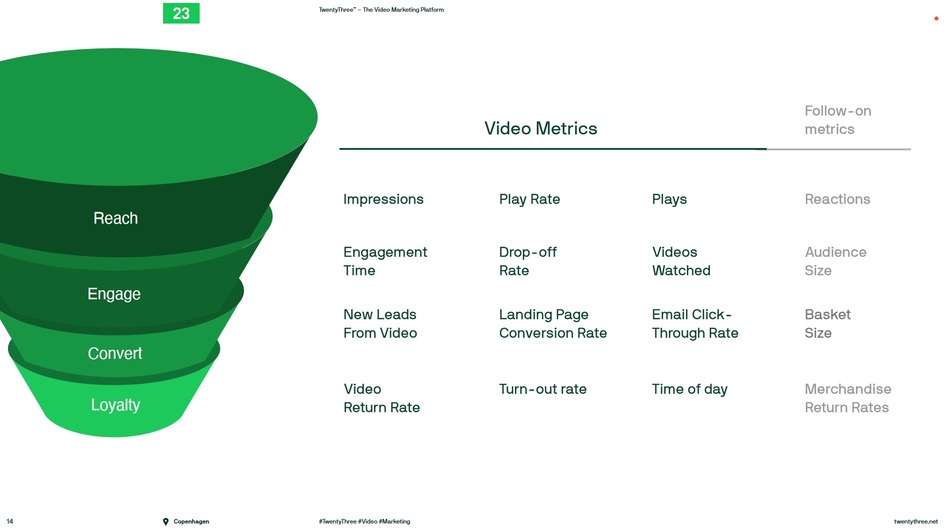
To get started, let's focus on how video analytics can inform targeting decisions. You'll want to pay attention to metrics like viewer demographics, engagement rates, watch times, and more when analyzing your videos' performance. If you need some guidance, Wistia has a great guide on measuring success through these metrics.
Incorporating Lead Scoring Models Based on Viewer Behavior

Moving onto lead scoring models based on viewer behavior - this is where things get really interesting.
- Action #1: Assign points to specific actions viewers take while watching your videos (e.g., clicking links or completing forms).
- Action #2: Set up thresholds for different levels of engagement (e.g., high vs. low) so you know which leads are worth pursuing further.
- Action #3: Use this information to create targeted follow-up campaigns for each segment of your audience.
If you're looking to dive deeper into this topic, Marketo's eBook on lead scoring for video is a fantastic resource.
So, there you have it - the secret sauce for leveraging video data effectively in your marketing strategy. Grasping and utilizing these ideas can help you craft more tailored, impactful promotions that really strike a chord with your desired crowd.
Ready to level up even further? Check out some insightful webinars from HubSpot here.
No time like the present - go forth and conquer the world of video marketing with data-driven strategies.
Using video analytics effectively can help businesses drive segmentation strategies, lead scoring efforts, and workflow optimizations. By analyzing metrics like viewer demographics, engagement rates, watch times and more, businesses can create targeted follow-up campaigns for each segment of their audience to create personalized and effective campaigns that resonate with their target audience.
FAQs in Relation to Video Marketing Adoption
How effective is video marketing strategy?
Video marketing strategies are highly effective in driving engagement, increasing brand awareness, and generating leads. According to Wyzowl's statistics, 84% of people say they've been convinced to buy a product or service by watching a brand's video. Additionally, videos can boost organic search traffic on websites by up to 157%. The key lies in creating high-quality content that resonates with your target audience.
How important is video in marketing?
Video has become an essential component of modern marketing due to its ability to convey complex information quickly and engage audiences emotionally. In fact, HubSpot reports that 78% of marketers believe video has directly improved their bottom line. Incorporating videos into your campaigns can help increase conversion rates, improve SEO rankings, and foster stronger connections with customers.
Why is video marketing so powerful?
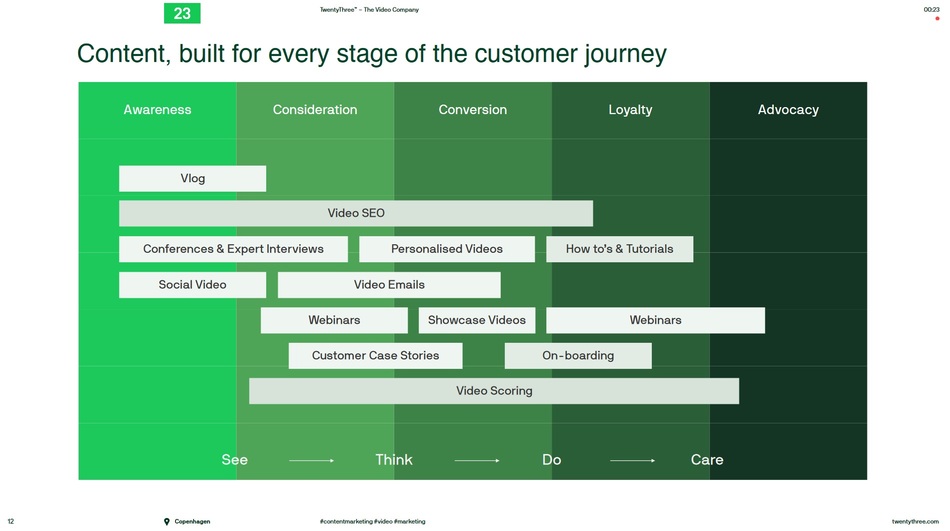
Video marketing harnesses the power of visual storytelling which appeals to human emotions more effectively than text alone. It also allows for easy consumption across multiple devices and platforms. A study from Forbes Agency Council found that viewers retain 95% of a message when watched through a video compared to only 10% when reading it as text - making it an impactful medium for communication.
How can you grow your business with video marketing?
To grow your business with video marketing, focus on creating engaging content that addresses customer pain points and showcases your unique value proposition. Utilize various formats such as explainer videos, testimonials, webinars, and live streams to reach a wider audience. Additionally, optimize videos for SEO by including relevant keywords in titles and descriptions while promoting them across social media channels for maximum exposure.
Conclusion
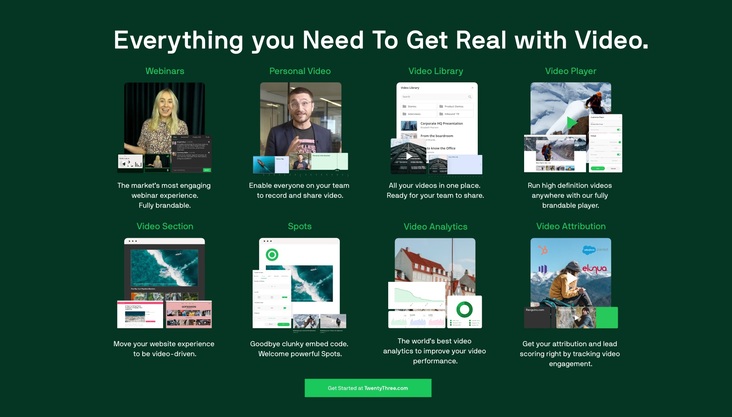
Video marketing adoption is a crucial aspect of any business strategy, especially for small companies with limited resources. Incorporating video into your marketing can help to drive website visitors and generate more leads. It's important to balance storytelling and metrics in your campaigns by setting clear goals and using results-oriented strategies.
Quantitative analysis plays a significant role in video marketing adoption, from identifying relevant KPIs to effectively using data analytics tools. Webinars are also an essential tool in the 2023 video landscape, as they can be integrated into various aspects of business operations while optimizing schedules based on attendance rates.
To maximize conversion rates through different forms, consider utilizing video sign-up forms that balance user experience with marketing goals. SEO also plays a vital role in accurate transcriptions for accessibility and translation while creating engaging thumbnails that capture attention.
If you're looking to improve your company's video marketing adoption strategy, contact Whitehat today for expert guidance!

